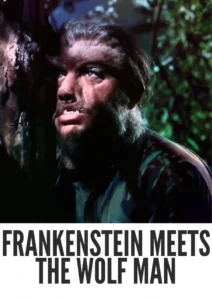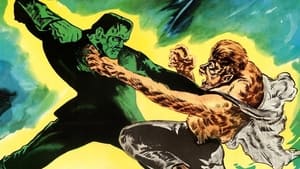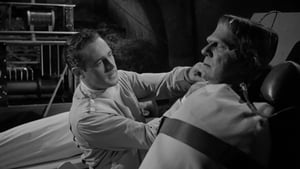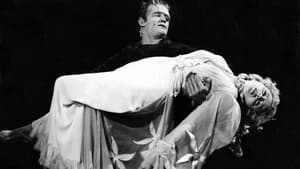Contact: info@alwanfilm.com
Video Sources 0 Views

Frankenstein Meets the Wolf Man 1943 Colorized
Synopsis
Frankenstein Meets the Wolf Man 1943 Colorized Review: A Classic Monster Mash-Up

Introduction
In the annals of classic horror cinema, few films embody the spirit of monster mash-ups as effectively as Frankenstein Meets the Wolf Man (1943). Directed by Roy William Neill, this film brings together two of Universal Pictures’ most iconic monsters in a thrilling and eerie cross-over. Released during a golden age of horror, this film not only entertains but also represents an important moment in the evolution of monster movies. In this review, we will explore the film’s impact, dissect its significance within the genre, and evaluate how it stands up to modern scrutiny, all while appreciating its place in the broader context of classic horror cinema.
Check The Full Colorized Movies List
Check Our Colorized Movies Trailer Channel
Understanding Frankenstein Meets the Wolf Man 1943 Colorized: Director, Cast, and Genre
Director’s Vision
Roy William Neill, a director renowned for his work in the mystery and horror genres, took on the challenging task of merging two monster universes with Frankenstein Meets the Wolf Man (1943). Neill’s vision was to create a cohesive narrative that would bring together the characters of Frankenstein’s Monster and the Wolf Man, both iconic creations from Universal’s horror legacy. His direction focused on blending horror elements with a sense of continuity between the two franchises, resulting in a film that respects the legacy of both monsters while creating a unique cinematic experience.
Neill’s approach involved a careful balance of suspense, horror, and drama, ensuring that both monsters received their due attention and that the story remained engaging throughout. His expertise in crafting atmospheric and tension-filled scenes played a crucial role in the film’s success.
The Iconic Performance of Actors
The cast of Frankenstein Meets the Wolf Man (1943) includes Lon Chaney Jr., who reprises his role as Lawrence Talbot/The Wolf Man. Chaney’s portrayal of the tragic werewolf is both haunting and sympathetic, capturing the character’s inner turmoil and desperation. His performance is a standout, bringing depth and nuance to a role that had already established him as a horror icon.
Bela Lugosi, another legendary figure in horror cinema, stars as the Monster in this film. Lugosi, known primarily for his role as Dracula, brings a different energy to the Monster, adding a layer of complexity to the character. His performance is both memorable and effective, providing a fresh take on the iconic role.
The supporting cast includes Anne Gwynne, who plays the role of a fortune teller, and Patric Knowles, who portrays a physician investigating the monstrous events. Their performances contribute to the film’s overall atmosphere and help drive the plot forward.
Exploring the Genre
Frankenstein Meets the Wolf Man (1943) is a quintessential example of the horror genre, specifically the monster movie subgenre. The film combines elements of Gothic horror, supernatural thrills, and dramatic storytelling. It reflects the era’s fascination with monsters and the macabre, while also offering a fresh take on familiar characters.
The film’s blending of horror and drama, along with its exploration of the monsters’ inner struggles, makes it a significant entry in the genre. Its successful integration of two distinct monster universes highlights the creativity and ambition of Universal Pictures during this period.
Exploring the World of Frankenstein Meets the Wolf Man 1943 Colorized: Plot and Characters
Detailed Synopsis
Frankenstein Meets the Wolf Man (1943) picks up where The Wolf Man (1941) left off, with Lawrence Talbot (Lon Chaney Jr.) being resurrected from his grave. The story begins with Talbot seeking a cure for his lycanthropy, hoping to rid himself of his werewolf curse. His quest leads him to a mysterious gypsy woman who hints at the existence of a cure, which in turn leads him to the remnants of the Frankenstein laboratory.
As Talbot explores the lab, he discovers the dormant Frankenstein Monster (Bela Lugosi), who has been in a state of suspended animation. The Monster is revived, leading to a series of events that pit the two creatures against each other. The film’s plot intertwines their fates, culminating in a dramatic and tragic confrontation.
The narrative delves into themes of resurrection, the quest for redemption, and the consequences of tampering with nature. The characters’ struggles and interactions drive the story forward, creating a compelling and memorable horror experience.
The Complex Protagonists
Both Lawrence Talbot and the Frankenstein Monster are portrayed as tragic figures, each grappling with their own curses. Talbot’s struggle with his werewolf identity and the Monster’s quest for understanding and acceptance form the emotional core of the film. Their interactions and conflicts highlight the themes of isolation and the search for a place in a world that rejects them.
The Art of Monster Mash-Ups
Combining Iconic Characters
The concept of a monster mash-up, where characters from different franchises collide, was relatively novel at the time. Frankenstein Meets the Wolf Man (1943) successfully merges two of Universal’s most beloved monsters, creating a unique and engaging narrative. The film’s ability to integrate these characters while maintaining their individual identities is a testament to the creativity of its creators.
The combination of Frankenstein’s Monster and the Wolf Man allowed for a fresh exploration of horror themes, blending their respective mythologies into a cohesive story. This approach not only entertained audiences but also paved the way for future crossovers and shared universes in horror cinema.
The Impact on the Horror Genre
The success of Frankenstein Meets the Wolf Man (1943) had a lasting impact on the horror genre. It demonstrated that monster mash-ups could be both commercially successful and creatively fulfilling. The film’s innovative approach to storytelling and character integration set a precedent for future horror films and contributed to the enduring popularity of monster movies.
The Legacy of Early Monster Crossovers
Evolution of Monster Mash-Ups
The concept of monster mash-ups has evolved significantly since Frankenstein Meets the Wolf Man (1943). While early crossovers were limited to individual studios and franchises, modern cinema has expanded the idea to include shared universes and collaborative projects. Films like Freddy vs. Jason (2003) and The Avengers (2012) reflect the continued fascination with combining iconic characters from different franchises.
The legacy of Frankenstein Meets the Wolf Man is evident in the way it influenced the development of crossover films and the broader genre of monster movies. Its success helped establish a blueprint for integrating multiple characters into a single narrative, contributing to the evolution of modern cinema.
Frankenstein Meets the Wolf Man 1943 Colorized and Its Impact on Horror Cinema
Influence on Subsequent Films
Frankenstein Meets the Wolf Man (1943) played a significant role in shaping the direction of horror cinema. Its successful combination of two iconic monsters demonstrated the potential for creative storytelling within the genre. The film’s influence can be seen in later monster movies and crossover films, which continue to explore the concept of bringing together beloved characters from different franchises.
The film’s impact extends beyond the horror genre, influencing the way cinematic universes are developed and maintained. Its success helped pave the way for more ambitious and interconnected storytelling in both horror and other genres.
Director’s Cinematic Legacy: Beyond Frankenstein Meets the Wolf Man 1943 Colorized
Roy William Neill’s Influence
Roy William Neill’s career extended beyond Frankenstein Meets the Wolf Man (1943), encompassing a diverse range of films and genres. Known for his work on the Sherlock Holmes series starring Basil Rathbone, Neill’s contributions to cinema are marked by his ability to craft engaging and suspenseful narratives.
Neill’s influence on the horror genre is evident in his skillful handling of atmospheric tension and character-driven stories. His work on Frankenstein Meets the Wolf Man remains a significant part of his legacy, showcasing his ability to merge genres and create memorable cinematic experiences.
Themes Explored in Frankenstein Meets the Wolf Man 1943 Colorized
Isolation, Redemption, and Consequences
Frankenstein Meets the Wolf Man (1943) explores themes of isolation, redemption, and the consequences of tampering with nature. Lawrence Talbot’s struggle with his werewolf curse and the Monster’s quest for understanding reflect the broader themes of loneliness and the desire for acceptance.
The film also delves into the consequences of scientific experimentation and the ethical implications of resurrecting the dead. These themes add depth to the story and contribute to its lasting impact on the horror genre.
Reception and Controversy Surrounding Frankenstein Meets the Wolf Man 1943 Colorized
Initial Reviews and Audience Reactions
Upon its release, Frankenstein Meets the Wolf Man (1943) received positive reviews for its engaging plot and strong performances. Critics praised the film for successfully integrating two iconic monsters into a cohesive narrative. Lon Chaney Jr. and Bela Lugosi’s performances were highlighted as key strengths, contributing to the film’s overall impact.
The film’s reception was also marked by its appeal to fans of the monster genre, who appreciated the creative crossover and the continuation of beloved characters’ stories. While some critics noted the film’s departure from earlier portrayals of the monsters, the overall response was favorable, reflecting its success in entertaining audiences.
Where to Watch Frankenstein Meets the Wolf Man 1943 Colorized Online
For those interested in experiencing Frankenstein Meets the Wolf Man (1943), several streaming platforms offer access to the film. Popular services such as Amazon Prime Video and Turner Classic Movies provide options for viewing the film online. Additionally, DVD and Blu-ray versions of the film are available for purchase, including special editions with additional features and commentary.
FAQs About Frankenstein Meets the Wolf Man 1943 Colorized
Q: What is the significance of Frankenstein Meets the Wolf Man (1943)?
A: Frankenstein Meets the Wolf Man (1943) is significant for being an early example of a monster mash-up, combining two iconic Universal Monsters into a single narrative. Its creative crossover and successful integration of the characters have had a lasting impact on the horror genre.
Q: Who directed Frankenstein Meets the Wolf Man (1943)?
A: Frankenstein Meets the Wolf Man (1943) was directed by Roy William Neill, known for his work in the mystery and horror genres, as well as his contributions to the Sherlock Holmes series.
Q: What themes are explored in Frankenstein Meets the Wolf Man (1943)?
A: The film explores themes of isolation, redemption, and the consequences of tampering with nature. It delves into the struggles of its protagonists and the ethical implications of resurrection and scientific experimentation.
Q: How has Frankenstein Meets the Wolf Man (1943) influenced the horror genre?
A: The film has influenced the horror genre by demonstrating the potential for creative crossovers and mash-ups. Its success helped establish a blueprint for integrating iconic characters into a cohesive narrative and paved the way for future films in the genre.
Conclusion
Frankenstein Meets the Wolf Man (1943) stands as a testament to the creativity and ambition of classic horror cinema. Directed by Roy William Neill and featuring standout performances by Lon Chaney Jr. and Bela Lugosi, the film successfully merges two iconic monsters into a thrilling and memorable narrative. Its impact on the horror genre is evident in its influence on subsequent monster movies and crossovers, reflecting the enduring appeal of Universal’s monster legacy. Whether viewed as a classic horror film or a pioneering example of genre crossovers, Frankenstein Meets the Wolf Man remains a significant and entertaining piece of cinematic history.















